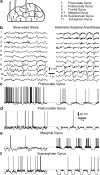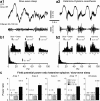Properties of slow oscillation during slow-wave sleep and anesthesia in cats
- PMID: 22016533
- PMCID: PMC3209581
- DOI: 10.1523/JNEUROSCI.2339-11.2011
Properties of slow oscillation during slow-wave sleep and anesthesia in cats
Abstract
Deep anesthesia is commonly used as a model of slow-wave sleep (SWS). Ketamine-xylazine anesthesia reproduces the main features of sleep slow oscillation: slow, large-amplitude waves in field potential, which are generated by the alternation of hyperpolarized and depolarized states of cortical neurons. However, direct quantitative comparison of field potential and membrane potential fluctuations during natural sleep and anesthesia is lacking, so it remains unclear how well the properties of sleep slow oscillation are reproduced by the ketamine-xylazine anesthesia model. Here, we used field potential and intracellular recordings in different cortical areas in the cat to directly compare properties of slow oscillation during natural sleep and ketamine-xylazine anesthesia. During SWS cortical activity showed higher power in the slow/delta (0.1-4 Hz) and spindle (8-14 Hz) frequency range, whereas under anesthesia the power in the gamma band (30-100 Hz) was higher. During anesthesia, slow waves were more rhythmic and more synchronous across the cortex. Intracellular recordings revealed that silent states were longer and the amplitude of membrane potential around transition between active and silent states was bigger under anesthesia. Slow waves were mostly uniform across cortical areas under anesthesia, but in SWS, they were most pronounced in associative and visual areas but smaller and less regular in somatosensory and motor cortices. We conclude that, although the main features of the slow oscillation in sleep and anesthesia appear similar, multiple cellular and network features are differently expressed during natural SWS compared with ketamine-xylazine anesthesia.
Figures







Similar articles
-
A novel slow (< 1 Hz) oscillation of neocortical neurons in vivo: depolarizing and hyperpolarizing components.J Neurosci. 1993 Aug;13(8):3252-65. doi: 10.1523/JNEUROSCI.13-08-03252.1993. J Neurosci. 1993. PMID: 8340806 Free PMC article.
-
Focal synchronization of ripples (80-200 Hz) in neocortex and their neuronal correlates.J Neurophysiol. 2001 Oct;86(4):1884-98. doi: 10.1152/jn.2001.86.4.1884. J Neurophysiol. 2001. PMID: 11600648
-
Spike-wave complexes and fast components of cortically generated seizures. II. Extra- and intracellular patterns.J Neurophysiol. 1998 Sep;80(3):1456-79. doi: 10.1152/jn.1998.80.3.1456. J Neurophysiol. 1998. PMID: 9744952
-
Electrophysiological correlates of sleep delta waves.Electroencephalogr Clin Neurophysiol. 1998 Aug;107(2):69-83. doi: 10.1016/s0013-4694(98)00051-0. Electroencephalogr Clin Neurophysiol. 1998. PMID: 9751278 Review.
-
Coalescence of sleep rhythms and their chronology in corticothalamic networks.Sleep Res Online. 1998;1(1):1-10. Sleep Res Online. 1998. PMID: 11382851 Review.
Cited by
-
A Thalamocortical Neural Mass Model of the EEG during NREM Sleep and Its Response to Auditory Stimulation.PLoS Comput Biol. 2016 Sep 1;12(9):e1005022. doi: 10.1371/journal.pcbi.1005022. eCollection 2016 Sep. PLoS Comput Biol. 2016. PMID: 27584827 Free PMC article.
-
Convergence of cortical and sensory driver inputs on single thalamocortical cells.Cereb Cortex. 2014 Dec;24(12):3167-79. doi: 10.1093/cercor/bht173. Epub 2013 Jul 3. Cereb Cortex. 2014. PMID: 23825316 Free PMC article.
-
Dihydropyridine calcium blockers do not interfere with non-rapid eye movement sleep.Front Neurosci. 2022 Oct 19;16:969712. doi: 10.3389/fnins.2022.969712. eCollection 2022. Front Neurosci. 2022. PMID: 36340773 Free PMC article.
-
Absence of Repetitive Correlation Patterns Between Pairs of Adjacent Neocortical Neurons in vivo.Front Neural Circuits. 2019 Jul 19;13:48. doi: 10.3389/fncir.2019.00048. eCollection 2019. Front Neural Circuits. 2019. PMID: 31379516 Free PMC article.
-
Signatures of Thalamocortical Alpha Oscillations and Synchronization With Increased Anesthetic Depths Under Isoflurane.Front Pharmacol. 2022 Jun 3;13:887981. doi: 10.3389/fphar.2022.887981. eCollection 2022. Front Pharmacol. 2022. PMID: 35721144 Free PMC article.
References
-
- Achermann P, Borbély AA. Mathematical models of sleep regulation. Front Biosci. 2003;8:s683–s693. - PubMed
-
- Bignall KE. Comparison of optic afferents to primary visual and polysensory areas of cat neocortex. Exp Neurol. 1967;17:327–343. - PubMed
-
- Blake H, Gerard RW. Brain potentials during sleep. Am J Physiol. 1937;119:692–703.
Publication types
MeSH terms
Substances
Grants and funding
LinkOut - more resources
Full Text Sources
Other Literature Sources
Medical
Miscellaneous
